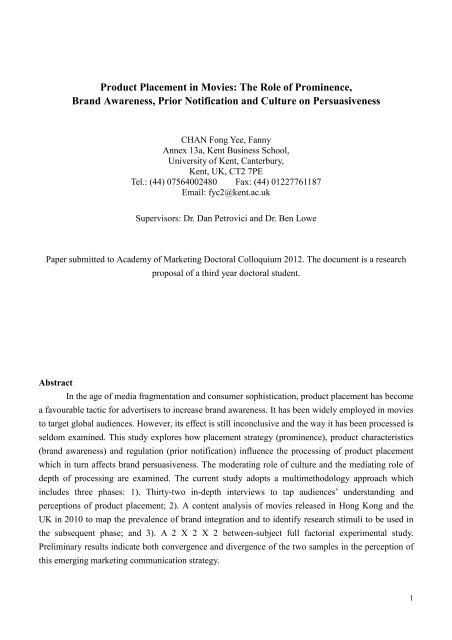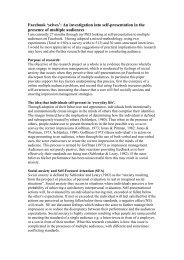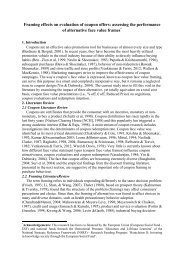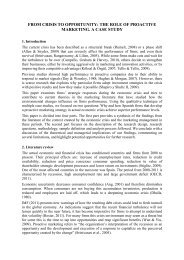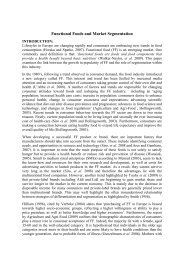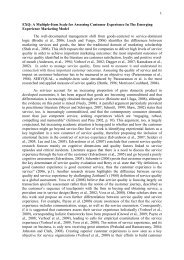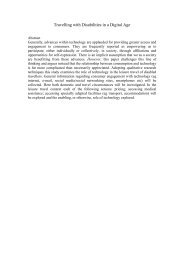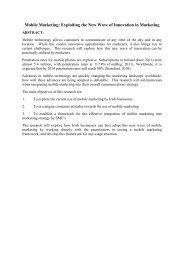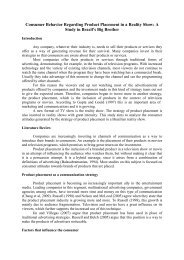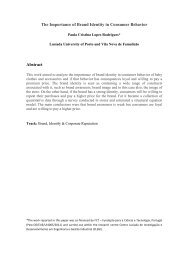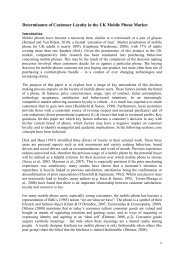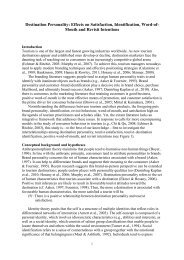Product Placement in Movies - Academy of Marketing
Product Placement in Movies - Academy of Marketing
Product Placement in Movies - Academy of Marketing
You also want an ePaper? Increase the reach of your titles
YUMPU automatically turns print PDFs into web optimized ePapers that Google loves.
<strong>Product</strong> <strong>Placement</strong> <strong>in</strong> <strong>Movies</strong>: The Role <strong>of</strong> Prom<strong>in</strong>ence,<br />
Brand Awareness, Prior Notification and Culture on Persuasiveness<br />
CHAN Fong Yee, Fanny<br />
Annex 13a, Kent Bus<strong>in</strong>ess School,<br />
University <strong>of</strong> Kent, Canterbury,<br />
Kent, UK, CT2 7PE<br />
Tel.: (44) 07564002480 Fax: (44) 01227761187<br />
Email: fyc2@kent.ac.uk<br />
Supervisors: Dr. Dan Petrovici and Dr. Ben Lowe<br />
Paper submitted to <strong>Academy</strong> <strong>of</strong> Market<strong>in</strong>g Doctoral Colloquium 2012. The document is a research<br />
Abstract<br />
proposal <strong>of</strong> a third year doctoral student.<br />
In the age <strong>of</strong> media fragmentation and consumer sophistication, product placement has become<br />
a favourable tactic for advertisers to <strong>in</strong>crease brand awareness. It has been widely employed <strong>in</strong> movies<br />
to target global audiences. However, its effect is still <strong>in</strong>conclusive and the way it has been processed is<br />
seldom exam<strong>in</strong>ed. This study explores how placement strategy (prom<strong>in</strong>ence), product characteristics<br />
(brand awareness) and regulation (prior notification) <strong>in</strong>fluence the process<strong>in</strong>g <strong>of</strong> product placement<br />
which <strong>in</strong> turn affects brand persuasiveness. The moderat<strong>in</strong>g role <strong>of</strong> culture and the mediat<strong>in</strong>g role <strong>of</strong><br />
depth <strong>of</strong> process<strong>in</strong>g are exam<strong>in</strong>ed. The current study adopts a multimethodology approach which<br />
<strong>in</strong>cludes three phases: 1). Thirty-two <strong>in</strong>-depth <strong>in</strong>terviews to tap audiences’ understand<strong>in</strong>g and<br />
perceptions <strong>of</strong> product placement; 2). A content analysis <strong>of</strong> movies released <strong>in</strong> Hong Kong and the<br />
UK <strong>in</strong> 2010 to map the prevalence <strong>of</strong> brand <strong>in</strong>tegration and to identify research stimuli to be used <strong>in</strong><br />
the subsequent phase; and 3). A 2 X 2 X 2 between-subject full factorial experimental study.<br />
Prelim<strong>in</strong>ary results <strong>in</strong>dicate both convergence and divergence <strong>of</strong> the two samples <strong>in</strong> the perception <strong>of</strong><br />
this emerg<strong>in</strong>g market<strong>in</strong>g communication strategy.<br />
1
Introduction<br />
<strong>Product</strong> placement, as an important component <strong>of</strong> market<strong>in</strong>g communication, frequently<br />
targets global audiences <strong>in</strong> the vehicles <strong>of</strong> movies, exported television programmes, music videos,<br />
onl<strong>in</strong>e games and etc. Every year billions and billions dollars are spent on plac<strong>in</strong>g brands <strong>in</strong> movies to<br />
reach the global audience. Accord<strong>in</strong>g to PQ Media (2007), global product placement market<br />
(<strong>in</strong>clud<strong>in</strong>g non-paid) grew by 24.2% and reached US$7.76 billion <strong>in</strong> 2006. In 2009, global branded<br />
enterta<strong>in</strong>ment spend<strong>in</strong>g totalled US$54.58 billion and paid product placement is forecasted to grow at<br />
accelerat<strong>in</strong>g rates (PQ Media 2010). Despite the fact that <strong>in</strong>creas<strong>in</strong>g budget is allocated to plac<strong>in</strong>g<br />
brands <strong>in</strong> movies to reach global consumers, no studies attempt to exam<strong>in</strong>e the effectiveness <strong>of</strong><br />
product placement across national and cultural boundaries. It is believed that the practice has changed<br />
from “relatively local and unsophisticated to one that is <strong>of</strong>ten global <strong>in</strong> scope and purpose” (Karrh,<br />
Frith and Callison 2001, p.3). The current research explores to what extent culture impacts placement<br />
effectiveness and also exam<strong>in</strong>es how placement strategy (prom<strong>in</strong>ence), product characteristics (brand<br />
awareness) and regulation (prior notification) together determ<strong>in</strong>e the level <strong>of</strong> process<strong>in</strong>g <strong>of</strong> product<br />
placement which <strong>in</strong> turn affects brand persuasiveness. The <strong>in</strong>clusion <strong>of</strong> cultural dimensions here is<br />
more <strong>of</strong> exploratory nature and has no <strong>in</strong>tention to draw any rigorous cultural conclusions (Cadogan<br />
2010). It is hoped to lay a foundation for future empirical work on the perception <strong>of</strong> product<br />
placement across cultures which is currently absent <strong>in</strong> this field. In spite <strong>of</strong> a few exceptions, there is a<br />
lack <strong>of</strong> theoretical framework to guide discussion on product placement effectiveness (Gregorio and<br />
Sung 2010). This research <strong>in</strong>tends to generate a comprehensive portrait <strong>of</strong> product placement <strong>in</strong><br />
movies and answer the follow<strong>in</strong>g broad research question which has not been addressed before:<br />
How do consumers across cultures process and evaluate product placement <strong>in</strong>formation<br />
and how does it affect the persuasive effectiveness?<br />
Research Aim and Objectives<br />
This research aims to understand how consumers <strong>in</strong> the Eastern (HK) and Western (UK)<br />
cultures are likely to perceive and evaluate product placement. It then explores what guides the<br />
persuasive effect <strong>of</strong> the practice across cultures and the <strong>in</strong>teraction between culture and different<br />
placement variables. The current study moves a step further to <strong>in</strong>vestigate placement effect from<br />
perception to persuasion by simultaneously consider<strong>in</strong>g two diverse cultures. It not only enriches<br />
literature <strong>in</strong> the field but will also provide practical feedbacks to global marketers. The study aims to<br />
answer the follow<strong>in</strong>g broad research questions (and sub-questions):<br />
RQ1: Do consumers <strong>in</strong> the two cultures exhibit different views towards the market<strong>in</strong>g practice<br />
product placement?<br />
a). How do they <strong>in</strong>terpret product placement and how do they perceive the different<br />
execution styles?<br />
b). What are their regulatory concerns regard<strong>in</strong>g product placement?<br />
RQ2: Do consumers <strong>in</strong> the two cultures have different exposure to product placement <strong>in</strong><br />
movies?<br />
a). How prevalent are brands appeared <strong>in</strong> the UK and HK movies?<br />
2
). What are the major characteristics <strong>of</strong> brands that appeared <strong>in</strong> the UK and HK<br />
movies?<br />
RQ3: What are the key determ<strong>in</strong>ants <strong>of</strong> the persuasive effect <strong>of</strong> product placement?<br />
Literature Review<br />
a). How does culture moderate the effect <strong>of</strong> prom<strong>in</strong>ence, brand awareness and prior<br />
notification on placement persuasiveness?<br />
b). Does depth <strong>of</strong> process<strong>in</strong>g mediate the persuasive effect <strong>of</strong> product placement?<br />
c). Are there any <strong>in</strong>dividual differences <strong>in</strong> the process<strong>in</strong>g <strong>of</strong> placement <strong>in</strong>formation?<br />
Previous literature <strong>of</strong> product placement can generally be grouped <strong>in</strong>to five categories: analysis<br />
<strong>of</strong> the nature <strong>of</strong> brand appearance <strong>in</strong> movies or television programmes (see Avery and Ferraro 2000;<br />
La Ferle and Edwards 2006); empirical studies <strong>of</strong> the effectiveness <strong>of</strong> product placement, usually<br />
restricted to a particular country and a particular consumer group (see d’Astous and Segu<strong>in</strong> 1999;<br />
Russell 2002; Van Reijmersdal, Neijens and Smit 2007; Cowley and Barron 2008; Homer 2009;<br />
Gregorio and Sung 2010); general discussion papers on the development and trends <strong>of</strong> product<br />
placement and the possible research frameworks (see Balasubramanian, Karrh and Patwardhan 2006;<br />
Hackley and Tiwsakul 2006; Taylor 2009); an exam<strong>in</strong>ation <strong>of</strong> practitioners’ views (see Pardun and<br />
McKee 2000; Karrh, McKee and Pardun 2003; Russell and Belch, 2005; Craig-Lees, Scott and Wong<br />
2008; Smit, Van Reijmersdal and Neijens 2009); and cross-cultural comparison <strong>of</strong> the <strong>in</strong>terpretation<br />
and ethical acceptability <strong>of</strong> product placement, <strong>in</strong>clud<strong>in</strong>g a meta analysis (see Gould, Gupta and<br />
Grabner-Kräuter 2000; Karrh, Frith and Callison 2001; McKechnie and Zhou 2003; Eisend 2009).<br />
Two <strong>in</strong>terest<strong>in</strong>g issues were noted here. First, the effect <strong>of</strong> product placement is <strong>in</strong>conclusive and the<br />
way product placement has been processed is seldom exam<strong>in</strong>ed. Previous research has been focused<br />
solely on manipulat<strong>in</strong>g execution factors, e.g. exposure frequency, prom<strong>in</strong>ence, modes <strong>of</strong> product<br />
placement (visual, audio), etc. However, no study attempts to explore the fundamental issue that how<br />
<strong>in</strong>formation <strong>in</strong> product placement is processed and its mediat<strong>in</strong>g role on the effectiveness. Second, the<br />
field is predom<strong>in</strong>ated by research conducted <strong>in</strong> the US and almost all the comparison studies revealed<br />
cross-cultural differences on acceptance and ethical concerns <strong>of</strong> product placement. It is anticipated<br />
that culture could have moderated the effectiveness <strong>of</strong> product placement.<br />
The moderat<strong>in</strong>g role <strong>of</strong> culture and the mediat<strong>in</strong>g role <strong>of</strong> depth <strong>of</strong> process<strong>in</strong>g<br />
One <strong>of</strong> the execution characteristics <strong>of</strong> product placement is prom<strong>in</strong>ence which is frequently<br />
exam<strong>in</strong>ed. <strong>Product</strong> placement differ from traditional advertis<strong>in</strong>g, its persuasive <strong>in</strong>tent is more implicit.<br />
However, brands placed prom<strong>in</strong>ently are more memorable. Perhaps prom<strong>in</strong>ence could be described as<br />
a double-edge sword for product placement. d’Astous and Segu<strong>in</strong> (1999, p.905) claimed that<br />
“obtrusiveness may not be a significant mediator <strong>of</strong> consumer evaluations”. This is <strong>in</strong>deed a valid<br />
claim s<strong>in</strong>ce different cultures may view obtrusiveness differently. Okazaki, Mueller and Taylor (2010)<br />
demonstrate that consumers from an assertive and performance-oriented culture respond to<br />
advertisements with s<strong>of</strong>t- and hard-sell approaches differently. Likewise, Terlutter, Diehl and Mueller<br />
(2010) found that respondents from an assertive culture evaluate pr<strong>in</strong>t advertisements with assertive<br />
3
appeals less favourably. Similar results on the dimension performance orientation were found <strong>in</strong> Diehl,<br />
Terlutter and Mueller’s (2008) study. It is likely that <strong>in</strong>dividuals with different cultural orientations<br />
will respond differently to prom<strong>in</strong>ently placed brands.<br />
Consumers’ attitude toward product placement <strong>of</strong> different product characteristic is seldom<br />
explored <strong>in</strong> previous literature (Tiwsakul, Hackley and Szmig<strong>in</strong> 2005). McCarty (2004) po<strong>in</strong>ted out<br />
that it is important to <strong>in</strong>vestigate what type <strong>of</strong> product/brand could benefit more from product<br />
placement. Respondents <strong>in</strong> McKechni and Zhou’s (2003) study reported that they are less likely to<br />
notice a placed brand if they are not familiar with it. It is possible that a well-known brand will be<br />
more persuasive than an unknown brand if placed <strong>in</strong> movies. Pae, Samiee and Tai (2002) suggested<br />
that well-known brands with transformational appeals were more successful <strong>in</strong> assertive and<br />
performance-oriented culture (such as HK). It is because well-established brands are synonymous<br />
with excellence <strong>in</strong> performance and success. In other words, cultural orientation may moderate the<br />
effect <strong>of</strong> brand awareness on perceived brand effectiveness.<br />
Currently movie producers are not obligated to notify audience for any upcom<strong>in</strong>g placed<br />
brands <strong>in</strong> the movie. Recently, the EU is consider<strong>in</strong>g pass<strong>in</strong>g a law which requires movie producers to<br />
announce product placements at the beg<strong>in</strong>n<strong>in</strong>g <strong>of</strong> the movie (Eisend, 2009). Previous studies <strong>in</strong>dicate<br />
cultural differences with respect to regulat<strong>in</strong>g product placement. Viewers <strong>in</strong> an assertive culture, the<br />
US, generally do not th<strong>in</strong>k that it should be banned or regulated by the government (Sung, Gregorio<br />
and Jung 2009) whereas respondents from a less assertive culture, S<strong>in</strong>gapore, agreed that the<br />
government should regulate the use <strong>of</strong> branded products <strong>in</strong> movies (Karrh, Frith and Callison 2001).<br />
Therefore it is believed that the two cultural dimensions “assertiveness” and “performance<br />
orientation” identified by House, Hanges, Javidan, Dorfman and Gupta (2004) will moderate the<br />
relationship between placement characteristics and placement effects.<br />
Research <strong>in</strong> consumer behaviour and social psychology proposed that effortlessly evaluat<strong>in</strong>g<br />
message arguments and product attributes is unlikely to happen (Petty and Cacioppo 1981). The<br />
elaboration likelihood model (ELM) is widely used <strong>in</strong> previous literature to understand how<br />
consumers process persuasive messages (Petty and Cacioppo 1986). When watch<strong>in</strong>g a movie, we are<br />
less defensive and tend to be more receptive <strong>of</strong> the presented <strong>in</strong>formation (Tsai, Liang and Liu 2007).<br />
<strong>Product</strong> placement <strong>in</strong> a stimuli-rich environment (movies) is less likely to attract defensive process<strong>in</strong>g.<br />
It is usually more embedded than traditional advertisement thus is harder to detect the persuasive<br />
<strong>in</strong>tent and activate one’s persuasion knowledge. However, a prom<strong>in</strong>ent, a priori notified placement or<br />
a placement <strong>of</strong> an unknown brand may be more likely to draw audience’s attention towards it. Their<br />
persuasion knowledge is triggered and may lead to extensive process<strong>in</strong>g <strong>of</strong> the messages (Friestad and<br />
Wright 1994; 1995). They may counterargue with the promotional content and are less likely to be<br />
persuaded. Therefore it is also hypothesized that prom<strong>in</strong>ence, brand awareness and prior notification<br />
lead to variations <strong>in</strong> placement process<strong>in</strong>g which then mediate placement effectiveness.<br />
Research Plan and Methodology<br />
The UK and HK were chosen for comparison because they are two promis<strong>in</strong>g markets for<br />
product placement. The ban <strong>of</strong> product placement on television has just been lifted <strong>in</strong> the UK. <strong>Product</strong><br />
4
placement <strong>in</strong>dustry <strong>in</strong> HK is now rapidly expanded to the onl<strong>in</strong>e medium (Eaton 2009). There is a<br />
press<strong>in</strong>g need to understand how consumers <strong>in</strong> the two markets perceive and evaluate placed brands.<br />
In addition, the two share very similar political, economic and social <strong>in</strong>frastructures but differ<br />
considerably on the two dimensions <strong>of</strong> concern (assertiveness and performance orientation. The<br />
research is divided <strong>in</strong>to three phases:<br />
Phase I: Exploratory <strong>in</strong>terviews. Thirty two <strong>in</strong>-depth <strong>in</strong>terviews were conducted to tap HK and UK<br />
audiences’ general understand<strong>in</strong>g and perceptions <strong>of</strong> product placement. Specifically the five aspects<br />
were explored: (a) respondents’ movie consumption habit and their general understand<strong>in</strong>g and<br />
experience about product placement; (b) their perception <strong>of</strong> different execution styles <strong>of</strong> product<br />
placement; (c) the effectiveness <strong>of</strong> product placement, (d) their views towards product placement and<br />
advertis<strong>in</strong>g <strong>in</strong> general, and (e) their regulatory and ethical concerns <strong>of</strong> product placement. All the<br />
<strong>in</strong>terviews were conducted face to face and audio recorded. The <strong>in</strong>terviews help to validate the<br />
conceptual framework and ref<strong>in</strong>e the experimental design <strong>of</strong> the later phase.<br />
Phase II: Content analysis. A content analysis <strong>of</strong> movies released <strong>in</strong> HK and the UK <strong>in</strong> 2010 with the<br />
highest box-<strong>of</strong>fice hits each week was conducted. The analysis documents the movie types, the<br />
frequency and execution <strong>of</strong> product placement. Both paid and non-paid placements were <strong>in</strong>cluded<br />
s<strong>in</strong>ce it is hard to judge if the producer had received money from a brand or not. This also applies to<br />
purposeful and non-purposeful placements because it is almost impossible to judge the <strong>in</strong>tention <strong>of</strong> a<br />
placement. The content analysis helps to map the prevalence <strong>of</strong> product placements that moviegoers <strong>in</strong><br />
the UK and HK were exposed to and also to identify the pool <strong>of</strong> research stimuli that could be used <strong>in</strong><br />
the next phase.<br />
Phase III: Experimental Study. Based on the pool <strong>of</strong> research stimuli selected from the<br />
second phase, a series <strong>of</strong> five-m<strong>in</strong>ute segments <strong>of</strong> movies was chosen and edited. All the research<br />
stimuli identified were pretested with twenty consumers to make sure that the manipulations are valid.<br />
Participants were <strong>in</strong>vited to watch one <strong>of</strong> the video clips and respond to an onl<strong>in</strong>e survey. A 2 (low vs.<br />
high prom<strong>in</strong>ence) X 2 (unknown vs. well-known brands) X 2 (without vs. with prior notification)<br />
between-subject full factorial experimental design was used. A sample size <strong>of</strong> 540 is targeted (with<br />
270 UK and 270 HK participants). Two matched samples are <strong>in</strong>tended so that direct comparisons <strong>of</strong><br />
the underly<strong>in</strong>g mechanisms <strong>of</strong> product placement between Eastern and Western consumers can be<br />
made which helps to confirm the stability <strong>of</strong> the model across cultures (Cadogan 2010).<br />
Prelim<strong>in</strong>ary F<strong>in</strong>d<strong>in</strong>gs from Exploratory Interviews and Content Analysis<br />
Exploratory <strong>in</strong>terviews <strong>in</strong>dicate that both samples are heavy consumers <strong>of</strong> movies. They watch<br />
movies every week and some even watch everyday. Watch<strong>in</strong>g movies onl<strong>in</strong>e or from DVDs are more<br />
and more popular among this young cohort. Prelim<strong>in</strong>ary results show both convergence and<br />
divergence <strong>of</strong> the two samples <strong>in</strong> the perception <strong>of</strong> product placement.<br />
Views towards advertis<strong>in</strong>g and product placement <strong>in</strong> general. The UK sample is relatively more<br />
positive about advertis<strong>in</strong>g. They see advertis<strong>in</strong>g a part <strong>of</strong> the daily lives which is essential to sponsor<br />
free programme services. HK audiences are comparatively less positive probably due to the fact that<br />
they have been bombarded by abundant ads which exist almost everywhere. Some <strong>of</strong> them comment<br />
5
that ads are “exaggerat<strong>in</strong>g” and are particularly annoyed by ads/promotion about loans and slimm<strong>in</strong>g<br />
care products. Few <strong>of</strong> them do not like advertis<strong>in</strong>g at all and express strong negative feel<strong>in</strong>gs.<br />
Compare to traditional advertis<strong>in</strong>g, young consumers found the covert market<strong>in</strong>g<br />
communication--product placement more acceptable. None <strong>of</strong> the UK respondents felt negative about<br />
this practice and only two HK respondents are aga<strong>in</strong>st it. Respondents regard it as a w<strong>in</strong>-w<strong>in</strong> practice<br />
for movie producers and brand owners. It is a good/clever way for promot<strong>in</strong>g products while at the<br />
same time br<strong>in</strong>gs movie producers extra fund<strong>in</strong>g.<br />
<strong>Product</strong> placement and brand familiarity. Obvious differences emerged between the UK and HK<br />
consumers with respect to the type <strong>of</strong> brands that are suitable for plac<strong>in</strong>g <strong>in</strong> movies. The UK<br />
respondents found that both unknown and well-known brands are suitable for product placement.<br />
They believe that small brands can benefit even more because <strong>of</strong> extra publicity. However, HK<br />
respondents found that well-known brands are more suitable for placement. They tend to associate the<br />
placement <strong>of</strong> unknown brands with promotional <strong>in</strong>tention.<br />
Regulatory and ethical concerns regard<strong>in</strong>g product placement. Both the UK and HK respondents<br />
understood that film production needs f<strong>in</strong>ancial support and do not f<strong>in</strong>d it ethically wrong that film<br />
producers receiv<strong>in</strong>g money from brand owners. Divergence is found <strong>in</strong> the two samples regard<strong>in</strong>g<br />
prior notify<strong>in</strong>g audience about product placement. UK audience generally are supportive towards prior<br />
notification. It <strong>in</strong>dicates that the film has permission to <strong>in</strong>tegrate the brands which are not used<br />
randomly. It also reduces compla<strong>in</strong>ts from audience. HK respondents are aga<strong>in</strong>st the practice and<br />
regard it as another round <strong>of</strong> promotion. The prior notification looks like rem<strong>in</strong>d<strong>in</strong>g them that the film<br />
is promot<strong>in</strong>g someth<strong>in</strong>g. The sell<strong>in</strong>g <strong>in</strong>tention becomes so obvious. Few <strong>of</strong> them reported that they<br />
may even consciously locate the brands <strong>in</strong> the movie. They believe prior notification would not<br />
change anyth<strong>in</strong>g because audience will be exposed to the brands regardless <strong>of</strong> be<strong>in</strong>g notified or not.<br />
Prevalence <strong>of</strong> brands <strong>in</strong> UK and HK movies. The table below details the characteristics <strong>of</strong> brand<br />
appearance <strong>in</strong> movies released <strong>in</strong> the UK and HK with highest box-<strong>of</strong>fice-hit each week <strong>in</strong> 2010.<br />
Surpris<strong>in</strong>gly, more brand appearances were recorded <strong>in</strong> movies released <strong>in</strong> the UK than <strong>in</strong> HK (277 vs.<br />
180 brands). The HK sample conta<strong>in</strong>s slightly more well-known brands and a much higher percentage<br />
<strong>of</strong> positively portrayed brands. A higher proportion <strong>of</strong> brands appeared <strong>in</strong> the UK sample is connected<br />
to the plot and has character <strong>in</strong>teraction.<br />
Table 1. The prevalence <strong>of</strong> brands <strong>in</strong> movies released <strong>in</strong> the UK and HK <strong>in</strong> 2010.<br />
Brand appearance characteristics UK HK<br />
No. <strong>of</strong> movies analyzed 18+11* 18+11*<br />
No. <strong>of</strong> brand appearance 242+35^ 145+35^<br />
No. <strong>of</strong> brand appearance per movie 3~34 2~31<br />
Most frequently appeared product category Durables Servic<strong>in</strong>g/ retail<strong>in</strong>g<br />
% <strong>of</strong> well-known brands appeared 74.37% 78.33%<br />
% <strong>of</strong> brands with character <strong>in</strong>teraction 62.82% 46.11%<br />
% <strong>of</strong> brands connect with the plot 37.55% 25.56%<br />
% <strong>of</strong> positively portrayed brands 10.47% 21.11%<br />
Note: *^ These figures belong to movies released <strong>in</strong> both countries.<br />
6
References:<br />
Avery, R.J. and Ferraro, R. (2000). Verisimilitude or advertis<strong>in</strong>g? Brand appearances on prime-time television. Journal <strong>of</strong> Consumer<br />
Affairs, 34(2), 217-244.<br />
Balasubramanian, S.K., Karrh, J.A., and Patwardhan, H. (2006). Audience response to product placements: An <strong>in</strong>tegrative framework<br />
and future research agenda, Journal <strong>of</strong> Advertis<strong>in</strong>g, 35(3), 115-141.<br />
Cadogan, J.W. (2010). Comparative, cross-cultural and cross-national research: A comment on good and bad practice. International<br />
Market<strong>in</strong>g Review, 27(6), 601-605.<br />
Cowley, E. and Barron, C. (2008). When product placement goes wrong: the effects <strong>of</strong> program lik<strong>in</strong>g and placement prom<strong>in</strong>ence.<br />
Journal <strong>of</strong> Advertis<strong>in</strong>g, 37(1), 89-98.<br />
Craig-Lees, M., Scott, J. and Wong, R. (2008). Perceptions <strong>of</strong> product placement practice across Australian and US practitioners.<br />
Market<strong>in</strong>g Intelligence & Plann<strong>in</strong>g, 26(5), 521-538.<br />
d’Astous, A. and Segu<strong>in</strong>, N. (1999). Consumer reactions to product placement strategies <strong>in</strong> television sponsorship. European Journal<br />
<strong>of</strong> Market<strong>in</strong>g, 33(9/10), 896-910.<br />
Diehl, S., Terlutter, R. and Mueller, B. (2008). The <strong>in</strong>fluence <strong>of</strong> culture on responses to the GLOBE dimension <strong>of</strong> performance<br />
orientation <strong>in</strong> advertis<strong>in</strong>g messages - Results from the US, Germany, France, Spa<strong>in</strong>, and Thailand. Advances <strong>in</strong> Consumer<br />
Research, 35, 269-275.<br />
Eaton, M. (2009). <strong>Product</strong> placement makes its debut Ontv. [Onl<strong>in</strong>e]. Available from:<br />
http://www.market<strong>in</strong>g-<strong>in</strong>teractive.com/news/10747 [Accessed 15 March 2011].<br />
Eisend, M. (2009). A cross-cultural generalizability study <strong>of</strong> consumers’ acceptance <strong>of</strong> product placements <strong>in</strong> movies. Journal <strong>of</strong><br />
Current Issues and Research <strong>in</strong> Advertis<strong>in</strong>g, 31, 15-26.<br />
Friestad, M. and Wright, P. (1994). The persuasion knowledge model: how people cope with persuasion attempts, Journal <strong>of</strong> Consumer<br />
Research, 21(June), 1-31.<br />
Friestad, M. and Wright, P. (1995). Persuasion knowledge model: Lay people’s and researcher’s beliefs about the psychology <strong>of</strong><br />
persuasion, Journal <strong>of</strong> Consumer Research, 22(June), 62-74.<br />
Gould S.J., Gupta P.B. and Grabner-Kräuter, S. (2000). <strong>Product</strong> placements <strong>in</strong> movies: A cross-cultural analysis <strong>of</strong> Austrian, French and<br />
American consumers’ attitudes toward this emerg<strong>in</strong>g <strong>in</strong>ternational promotional medium. Journal <strong>of</strong> Advertis<strong>in</strong>g, 29(4), 41-58.<br />
Gregorio, F. and Sung, Y. (2010). Understand<strong>in</strong>g attitudes toward and behaviours <strong>in</strong> response to product placement. Journal <strong>of</strong><br />
Advertis<strong>in</strong>g, 39(1), 83-96.<br />
Hackley, C. and Tiwsakul, R. (2006). Enterta<strong>in</strong>ment market<strong>in</strong>g and experiential consumption. Journal <strong>of</strong> Market<strong>in</strong>g Communications,<br />
12(1), 63-75.<br />
Homer, P.M. (2009). <strong>Product</strong> placements: The impact <strong>of</strong> placement type and repetition on attitude. Journal <strong>of</strong> Advertis<strong>in</strong>g, 38 (3), 21-32.<br />
House, R.J., Hanges, P.W., Javidan, M., P. Dorfman, and V. Gupta (2004).Culture, Leadership, and Organizations: The GLOBE Study <strong>of</strong><br />
62 Societies. Thousand Oaks CA: Sage Publications.<br />
Karrh, J.A. (1998). Brand placement: A review. Journal <strong>of</strong> Current Issues and Research <strong>in</strong> Advertis<strong>in</strong>g, 20(2), 31-49.<br />
Karrh, J.A., Frith, K.T., and Callison, C. (2001). Audience attitudes towards brand (product) placement: S<strong>in</strong>gapore and United States.<br />
International Journal <strong>of</strong> Advertis<strong>in</strong>g, 20(1), 3-24.<br />
Karrh, J.A., McKee, K.B. and Pardun, C.J. (2003). Practitioners’ evolv<strong>in</strong>g views on product placement effectiveness. Journal <strong>of</strong><br />
Advertis<strong>in</strong>g Research, 43(2), 138-149.<br />
La Ferle, C. and Edwards, S. M. (2006). <strong>Product</strong> placement: How brands appear on television. Journal <strong>of</strong> Advertis<strong>in</strong>g, 35 (4), 65-86.<br />
McCarty, J. A. (2004). <strong>Product</strong> placement: The nature <strong>of</strong> the practice and potential avenues <strong>of</strong> <strong>in</strong>quiry. In L. J. Shrum (Ed.), The<br />
Psychology <strong>of</strong> Enterta<strong>in</strong>ment Media (pp. 45-61). Mahwah, NJ: Lawrence Erlbaum.<br />
McKechnie, S. and Zhou, J. (2003). <strong>Product</strong> placement <strong>in</strong> movies: a comparison <strong>of</strong> Ch<strong>in</strong>ese and American consumers' attitudes.<br />
International Journal <strong>of</strong> Advertis<strong>in</strong>g, 22(2), 349-374.<br />
Okazaki, S., Mueller. B. and Taylor, C. (2010). Global consumer culture position<strong>in</strong>g: Test<strong>in</strong>g perceptions <strong>of</strong> s<strong>of</strong>t-sell and hard-sell<br />
advertis<strong>in</strong>g appeals between U.S. and Japanese consumers. Journal <strong>of</strong> International Market<strong>in</strong>g, 18(2), 20-34.<br />
Pae, J., Samiee, S. and Tai, H.C. (2002). Global advertis<strong>in</strong>g strategy: The moderat<strong>in</strong>g role <strong>of</strong> brand familiarity and execution style.<br />
International Market<strong>in</strong>g Review, 19 (2), 176-189.<br />
Pardun, C.J. and McKee, K.B. (2000). <strong>Product</strong> placements as public relations: An exploratory study <strong>of</strong> the role <strong>of</strong> the public relations<br />
firm. Public Relations Review, 25(4), 481-493.<br />
Petty, R.E. and Cacioppo, J.T. (1981). Attitudes and Persuasion: Classic and Contemporary Approaches. Dubuque, IA: Wm. C. Brown.<br />
Petty, R.E. and Cacioppo, J.T. (1986). The elaboration likelihood model <strong>of</strong> persuasion. In L. Berkowitz (Ed.), Advances <strong>in</strong> Experimental<br />
Social Psychology (Vol.19, pp.123-205). New York: Academic Press.<br />
PQ Media (2007). Media global product placement forecast series 2006-2010: Country-by-country analysis. Stamford, CT.<br />
Russell, C.A. (2002). Investigat<strong>in</strong>g the effectiveness <strong>of</strong> product placements <strong>in</strong> television shows: the role <strong>of</strong> modality and plot connection<br />
congruence on brand memory and attitude. Journal <strong>of</strong> Consumer Research, 29(3), 306-319.<br />
Russell, C.A. and Belch, M. (2005). A managerial <strong>in</strong>vestigation <strong>in</strong>to the product placement <strong>in</strong>dustry. Journal <strong>of</strong> Advertis<strong>in</strong>g Research,<br />
45(1), 73-92.<br />
Smit, E., Van Reijmersdal, E. and Neijens, P. (2009). Today’s practice <strong>of</strong> brand placement and the <strong>in</strong>dustry beh<strong>in</strong>d it. International<br />
Journal <strong>of</strong> Advertis<strong>in</strong>g, 28(5), 761-782.<br />
Sung, Y., Gregorio, F. and Jung, J. (2009). Non-student consumer attitudes towards product placement: Implications for public policy<br />
and advertisers. International Journal <strong>of</strong> Advertis<strong>in</strong>g, 28 (2), 257-285.<br />
Taylor, C.R. (2009). <strong>Product</strong> placement: a hot topic gets hotter. International Journal <strong>of</strong> Advertis<strong>in</strong>g, 28(5), 753-756.<br />
Terlutter, R., Diehl S. and Mueller B. (2010). The cultural dimension <strong>of</strong> assertiveness <strong>in</strong> cross-cultural advertis<strong>in</strong>g: The perception and<br />
evaluation <strong>of</strong> assertive advertis<strong>in</strong>g appeals. International Journal <strong>of</strong> Advertis<strong>in</strong>g, 29(3), 369-339.<br />
Tiwsakul, A.R., Hackley, C. and Szmig<strong>in</strong>, I. (2005). Explicit, non-<strong>in</strong>tegrated product placement <strong>in</strong> British television programmes.<br />
International Journal <strong>of</strong> Advertis<strong>in</strong>g, 24(1), 95-111.<br />
Tsai, M., Liang, W., and Liu, M. (2007). The effects <strong>of</strong> sublim<strong>in</strong>al advertis<strong>in</strong>g on consumer attitudes and buy<strong>in</strong>g <strong>in</strong>tentions. International<br />
Journal <strong>of</strong> Management, 24(1), 3-14.<br />
Van Reijmersdal, E., Neijens, P. and Smit, E. (2007). Effects <strong>of</strong> television brand placement on brand image. Psychology and Market<strong>in</strong>g,<br />
24(5), 403-420.<br />
7


